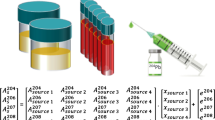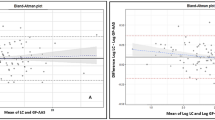Abstract
It is widely recognized that lead (Pb) affects children’s cognitive function, even at relatively low blood lead levels (<10 μg dL–1). The determination of the source of Pb in children is essential for effective risk management. The use of multi-collector ICPMS (MC-ICPMS) for isotope ratio measurements of Pb in environmental and biological samples was examined for this purpose. MC-ICPMS with an instrumental mass fractionation correction by Tl allowed accurate isotope ratio measurements of the Pb isotopic reference material NIST SRM 981. However, the presence of matrix elements (Al, Ca, Fe and Na) at more than 10 mg kg–1 in the sample solution significantly deteriorated the accuracy. The separation of Pb from the matrix is necessary for accurate measurements of the isotope ratio of Pb in environmental and biological samples. Bromide-complexation, followed by anion exchange was found to be satisfactory in terms of the recovery of Pb (90 to 104%) and the efficiency of matrix separation. The procedure was applied to a preliminary source analysis of Pb in the blood of Japanese children, and a significant contribution of indoor dust was demonstrated.
Similar content being viewed by others
References
Center for Disease Control and Prevention (CDC), Preventing Lead Poisoning in Young Children, Atlanta, CDC, 1991.
B. P. Lanphear, K. Dietrich, P. Auinger, and C. Cox, Public Health Reports, 2000, 115, 521.
J. Schwartz, Environ. Res., 1994, 65, 42.
B. P. Lanphear, R. Hornung, J. Khoury, K. Yolton, P. Baghurst, D. C. Bellinger, R. L. Canfield, K. N. Dietrich, R. Bornschein, T. Greene, S. J. Rothenberg, H. L. Needleman, L. Schnaas, G. Wasserman, J. Graziano, and R. Roberts, Environ. Health Perspect., 2005, 113, 894.
M. Kaji, Biomed. Re. Trace Elements, 2007, 18, 199.
W. I. Manton, Arch. Environ. Health, 1977, 3, 149.
O. Tera, D. W. Schwartzman, and T. R. Watkins, Arch. Environ. Health, 1985, 40, 120.
Y. Yaffe, C. P. Flessel, J. J. Wesolowski, A. Del Rosario, G. N. Guirguis, T. E. Degarmo, and G. C. Coleman, Arch. Environ. Health, 1983, 38, 237.
M. Rehkamper and K. Mezger, J. Anal. At. Spectrom., 2000, 15, 1451M.
A. J. Walder, D. Koller, N. M. Reed, R. C. Hutton, and P. A. Freedman, J. Anal. At. Spectrom., 1993, 8, 1037.
W. M. White, F. Albarede, and P. Telouk, Chem. Geol., 2000, 167, 257.
J. Barling and D. Weis, J. Anal. At. Spectrom., 2008, 23, 1017.
G. H. Fontaine, B. Hattendorf, B. Bourdon, and D. Gunther, J. Anal. At. Spectrom., 2009, 24, 637.
G. Fortunato, A. Ritter, and D. Fabian, Analyst, 2005, 130, 898.
M. K. Reuer, E. A. Boyle, and B. C. Grant, Chem. Geol., 2003, 200, 137.
K. Okamoto and K. Fuwa, Anal. Chem., 1984, 56, 1758.
M. Takagi, S. Tamiya, J. Yoshinaga, H. Utagawa, A. Tanaka, H. Seyama, Y. Shibata, A. Uematsu, and M. Kaji, J. Environ. Chem., 2008, 18, 521.
A. G. Oomen, A. Hack, M. Minekus, E. Zeijdner, C. Cornelis, G. Schoeters, W. Verstraete, T. V. D. Wiele, J. Wragg, C. J. M. Rompelberg, A. J. A. M. Sips, and J. H. V. Wijnen, Environ. Sci. Technol., 2002, 36, 3326.
T. Matsumoto, Y. Hirao, M. Iwasaki, E. Fukuda, H. Hanami, S. Nara, and A. Kimura, Bunseki Kagaku, 1986, 35, 590.
Hitachi High-Technologies Corporation, Nobias Chelate Column, http://www.hitachi-hitec.com/index.html.
D. Weis, B. Kieffer, C. Maerschalk, J. Barling, J. de Jong, G. A. Williams, D. Hanano, W. Pretorius, N. Mattielli, J. S. Scoates, A. Goolaerts, R. M. Friedman, and J. B. Mahoney, Geochem. Geophys. Geosyst., 2006, 7, 1.
A. Cocherie and M. Robert, Chem. Geol., 2007, 243, 90.
S. Ehrlich, Z. Karpas, L. Dor, and L. Halicz, J. Anal. At. Spectrom., 2001, 16, 975.
D. M. Unruh, D. L. Fey, and S. E. Church, USGS Open-File Report 00-038, 2000.
N. Kobayashi, W. Naito, and J. Nakanishi, “Risk Assessment Documents”, ed. Research Center for Chemical Risk Management, National Institute of Advanced Industrial Science and Technology, 2006, Maruzen, Tokyo.
N. N. Aung, J. Yoshinaga, and J. Takahashi, Environ. Health Prev. Med., 2004, 9, 257.
M. Murozumi, S. Nakamura, and K. Yoshida, Nippon Kagaku Kaishi, 1982, 1479.
M. Takaoka, J. Yoshinaga, and A. Tanaka, J. Environ. Monit., 2006, 8, 393.
J. L. Adgate, C. Weisel, Y. Wang, G. G. Rhoads, and P. J. Lioy, Environ. Res., 1995, 70, 134.
B. P. Lanphear, M. Weitzman, N. L. Winter, S. Eberly, B. Yakir, M. Tanner, M. Emond, and T. D. Matte, Am. J. Public Health, 1996, 86, 1416.
Author information
Authors and Affiliations
Corresponding author
Rights and permissions
About this article
Cite this article
Takagi, M., Yoshinaga, J., Tanaka, A. et al. Isotope Ratio Analysis of Lead in Blood and Environmental Samples by Multi-collector Inductively Coupled Plasma Mass Spectrometry. ANAL. SCI. 27, 29–35 (2011). https://doi.org/10.2116/analsci.27.29
Received:
Accepted:
Published:
Issue Date:
DOI: https://doi.org/10.2116/analsci.27.29




